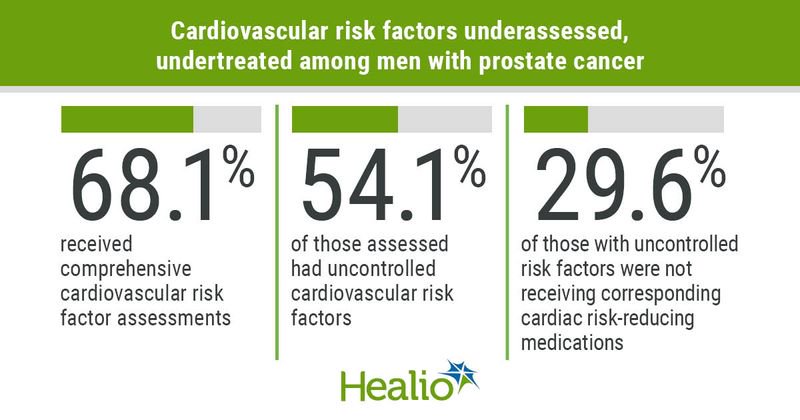Cardiovascular risk factors often undertreated among men with prostate cancer
Veterans with prostate cancer often had underassessed and undertreated cardiovascular risk factors, according to study results published in JAMA Network Open.
Initiation of androgen deprivation therapy did not appear associated with considerable improvement in assessment or management of these risk factors, results showed.

“These findings highlight the need for closer clinical attention and interventions to mitigate cardiac risk in patients with prostate cancer,” Lova Sun, MD, fellow in hematology and oncology at Perelman School of Medicine at University of Pennsylvania, told Healio. “Providers treating patients with prostate cancer — including oncologists, primary care providers and cardiologists — should be cognizant of the high burden of cardiovascular risk factors in this population, and be encouraged to closely monitor and manage cardiovascular risk factors with a combination of lifestyle and medication strategies.”
Cardiovascular disease is a leading cause of mortality among men with prostate cancer, and ADT may exacerbate cardiovascular risk. However, it remained unclear to what extent men with prostate cancer adhered to guideline-recommended assessment and management of cardiovascular risk factors upon ADT initiation, according to study background.
Sun and colleagues conducted a cross-sectional analysis of 90,494 men (median age, 66 years; interquartile range, 62-70) diagnosed with prostate cancer between 2010 and 2017.
All men underwent treatment within the US Veterans Health Administration. One-quarter (25.1%; n = 22,700) received ADT within 1 year of prostate cancer diagnosis.

“Though androgen deprivation therapy has been shown in multiple studies to increase cardiovascular risk in patients with prostate cancer, it was not known how well these patients' cardiac risk was being assessed and managed,” Sun told Healio. “The Veterans Affairs database presented a unique opportunity to investigate cardiovascular risk management in a high-risk population.”
Key outcome measures included rate of comprehensive cardiovascular risk factor assessment — in which blood pressure, cholesterol and glucose levels were recorded — as well as rates of uncontrolled and untreated cardiovascular risk factors.
Sun and colleagues defined controlled risk factors as blood pressure lower than 140 mm Hg/99 mm Hg, low-density lipoprotein cholesterol less than 130 mg/dL, and hemoglobin A1c less than 7%. They defined cardiovascular risk factor treatment as receipt of cardiac risk-reducing medications.
Researchers used multivariable risk difference regression to assess the association between atherosclerotic cardiovascular disease or ADT initiation and these outcomes.
More than two-thirds (68.1%; 95% 67.8-68.3) of men received comprehensive cardiovascular risk factor assessments. This rate increased steadily during the study period, from 57.9% (95% CI, 57-58.7) in 2010 to 76.8% (95% CI, 76-77.6) in 2017.
More than half (54.1%; 95%CI, 53.7-54.4) of those assessed had uncontrolled cardiovascular risk factors; these included uncontrolled blood pressure (35.7%; 95% CI, 35.3-36), cholesterol (19.8%; 95% CI, 19.5-20) or glucose levels (19.1%; 95% CI, 18.8-19.4). More than one-quarter (29.6%; 95% CI, 29.2-30) of those with uncontrolled risk factors were not receiving corresponding cardiac risk-reducing medications.
Men without atherosclerotic disease who did not receive ADT served as the reference group.
In comparison, men with atherosclerotic cardiovascular disease who did not receive ADT had a 10.4% (95%, 9.5-11.3%) higher probability of comprehensive cardiovascular risk factor assessment, a 4% (95% CI, 2.9-5.1) lower risk for uncontrolled cardiovascular risk factors and a 22.2% (95% CI, 21.1-23.3) lower risk for untreated cardiovascular risk factors.
Men with atherosclerotic cardiovascular disease who received ADT had a 23.3% (95% CI, 21.8-24.9%) lower risk for untreated cardiovascular risk factors compared with the reference group.
Analyses of men without atherosclerotic cardiovascular disease who received ADT showed they had a 3% (95% CI, 2.1-3.9) higher probability of comprehensive cardiovascular risk factor assessment, a 2.6% (95% CI, 1.6-3.5) higher risk for uncontrolled cardiovascular risk factors and a 5.4% (4.2-6.6) lower risk for untreated cardiovascular risk factors.
“Though it was encouraging to see that cardiovascular risk factor assessment did improve over time, we were surprised that over 1 in 5 veterans with prostate cancer did not receive comprehensive risk factor assessment even in recent years,” Sun said. “It was also notable that patients initiating androgen deprivation therapy — despite increasing knowledge around cardiovascular risks — did not appear to be getting closer cardiovascular screening and management.”
Future studies should be designed to test interventions that can improve the stratification and mitigation of cardiac risks among men with prostate cancer, Sun said.
“As improving treatments for prostate and other malignancies translate into better cancer-specific survival, survivorship issues and competing risks — including cardiovascular disease — will continue to be critical in optimizing long-term outcomes for patients with cancer,” Sun said.

